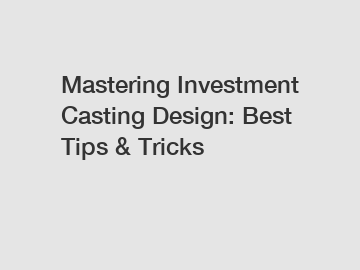Mastering Investment Casting Design: Best Tips & Tricks.
Investment casting, also known as lost wax casting, is a highly versatile and precise manufacturing process that has been practiced for centuries. It is widely used in industries such as aerospace, automotive, and jewelry, to create complex and interlocking metal parts with exceptional detail and quality. Mastering investment casting design requires understanding the intricacies of the process and incorporating best practices. In this article, we will explore some of the best tips and tricks to help you optimize your investment casting design.
1. Design for manufacturability.

Designing for manufacturability is crucial when it comes to investment casting. The process involves creating a wax pattern that is coated with a ceramic shell before being subjected to high temperatures to melt away the wax and create a cavity for molten metal. To ensure a successful casting, it is essential to consider factors such as draft angles, wall thickness, and parting lines during the design stage. Incorporating these considerations will improve moldability and reduce the likelihood of defects.
2. Wall thickness optimization.
The wall thickness of an investment casting plays a significant role in achieving desired results. It is essential to balance the thickness requirements for structural integrity and functionality, while also considering the limitations of the casting process. A well-designed part will have consistent and uniform wall thickness to ensure a smooth flow of molten metal during the casting process and minimize problems such as shrinkage and distortion.
3. Avoid undercuts and challenging geometries.
Investment casting is particularly suitable for creating complex and intricate shapes, but certain design features can pose challenges during the casting process. Undercuts, for example, can make it difficult to remove the wax pattern from the mold without causing damage. Designing parts with simple geometries and avoiding complex features will enhance the manufacturability of investment castings and increase the chances of a successful outcome.
4. Consider material selection.
Choosing the right material for investment casting is essential for achieving the desired mechanical properties and overall performance of the final part. Different materials have different melting points, flow characteristics, and solidification behaviors, which can impact the casting process and the quality of the final product. It is crucial to understand the material's properties and consult with experienced casting professionals to select the most suitable material for your specific application.
5. Utilize simulation software.
Simulation software can be a valuable tool in optimizing investment casting design. It allows designers to simulate the casting process digitally, predicting potential issues such as defects, shrinkage, and filling problems. By utilizing simulation software, designers can make informed decisions to improve the design and avoid costly iterations and adjustments in the physical prototyping stage.
In conclusion, mastering investment casting design requires a combination of knowledge, experience, and attention to detail. By considering factors such as design for manufacturability, wall thickness optimization, geometry simplification, material selection, and leveraging simulation software, designers can enhance the success rate of investment casting and achieve high-quality results.
If you require further assistance or have any questions regarding investment casting, please do not hesitate to contact us. We are here to help you optimize your design and bring your vision to life.
Contact us now to explore the possibilities of investment casting and take your projects to new heights.
Want more information on Machinery Parts Lost Wax Casting exporter, Lost wax casting for sporting equipment, auto parts casting exporter? Feel free to contact us.



Comments
Please Join Us to post.
0